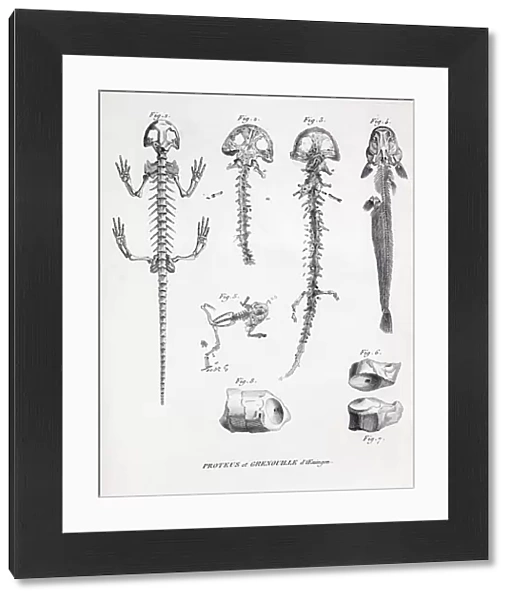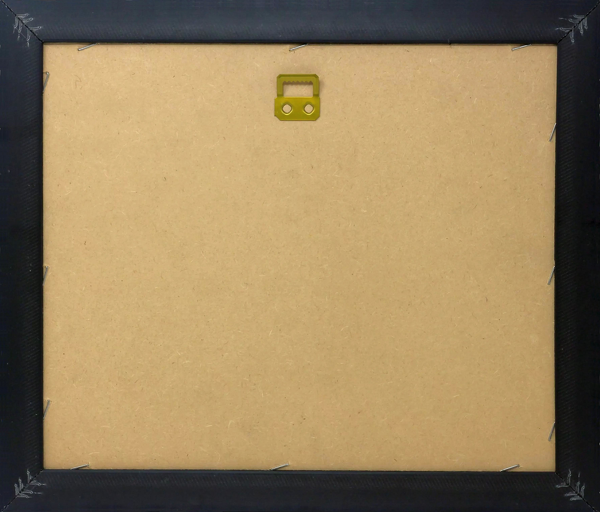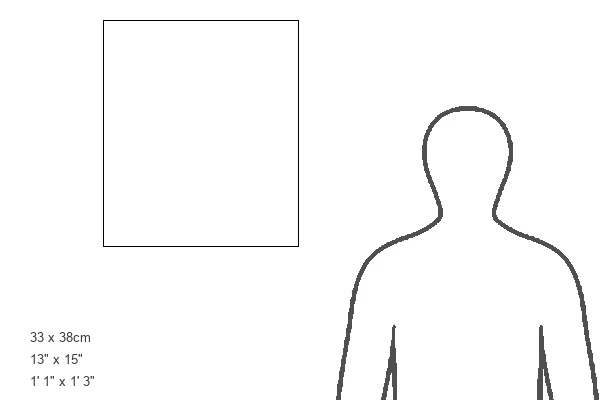Framed Print : 1812 Cuvier on Scheuchzers flood victim
![]()

Framed Photos from Science Photo Library
1812 Cuvier on Scheuchzers flood victim
Illustration in Vol. 4 of Cuviers " Ossamens Fossiles" 1812. In 1726 Scheuchzer illustrated Homo Diluvii testis as a fossil human victim of the flood. In 1811 Baron Cuvier, who famously said " there are no human fossils", took a look at the specimen. His work revealed more of the limbs and many obviously non-human features. He identified it correctly as a giant Salamander close to proteus. There are many accounts of this incident but few note that Cuvier cites two different specimens (here Fig 2 is Scheuchzer s, but Fig 3 is different and more complete specimen of Dr. Amman of Zurich). The current genus name Andrias was coined in 1837. Hence the current scientific name Andrias (image of man) scheuchzeri. There is a living member of the genus A. davidianus, the Japanese giant salamander. Cuvier also showed Scheuchzers illustrated human vertebrae" (Fig. 6&7) belong to a fossil crocodile
Science Photo Library features Science and Medical images including photos and illustrations
Media ID 6317395
© PAUL D STEWART/SCIENCE PHOTO LIBRARY
Bible Black And White Creationism Creationist Cuvier Flood Human Fossil Paleontologist Physica Sacra Giant Salamander Mono Chrome Palaeontology Scheuchzer The Flood
14"x12" (38x32cm) Modern Frame
Discover the intriguing history of paleontology with our Framed Prints featuring the iconic illustration "1812 Cuvier on Scheuchzer's Flood Victim" by Paul D. Stewart from Science Photo Library. This captivating image is taken from Vol. 4 of Cuvier's "Ossamens Fossiles," published in 1812. Depicting renowned naturalist Georges Cuvier examining the famous fossil "Homo Diluvii testis" or "The Man of the Flood" by Johann Jakob Scheuchzer, this print is a testament to the rich history of scientific discovery. Bring this piece of history into your home or office and start a conversation with our beautifully framed, museum-quality prints.
Wood effect frame, card mounted, 10x8 archival quality photo print. Overall outside dimensions 14x12 inches (38x32cm). Environmentally and ozone friendly, 40mm wide x 15mm Polycore® moulding has the look of real wood, is durable and light and easy to hang. Biodegradable and made with non-chlorinated gases (no toxic fumes) it is efficient; producing 100 tons of polystyrene can save 300 tons of trees! Prints are glazed with lightweight, shatterproof, optical clarity acrylic (providing the same general protection from the environment as glass). The back is stapled hardboard with a sawtooth hanger attached. Note: To minimise original artwork cropping, for optimum layout, and to ensure print is secure, the visible print may be marginally smaller
Contemporary Framed and Mounted Prints - Professionally Made and Ready to Hang
Estimated Image Size (if not cropped) is 18.7cm x 24.4cm (7.4" x 9.6")
Estimated Product Size is 32.5cm x 37.6cm (12.8" x 14.8")
These are individually made so all sizes are approximate
Artwork printed orientated as per the preview above, with portrait (vertical) orientation to match the source image.
EDITORS COMMENTS
This print showcases an illustration from Volume 4 of Cuvier's "Ossamens Fossiles" published in 1812. The image depicts a significant moment in the history of paleontology, specifically related to the controversial topic of human fossils and their connection to biblical events. In 1726, Scheuchzer presented his famous illustration titled "Homo Diluvii testis" depicting a fossilized human victim of the flood described in the Bible. However, renowned Baron Cuvier, who famously declared that there were no human fossils, examined this specimen in 1811 with intriguing results. Cuvier's meticulous work revealed additional limbs and distinct non-human characteristics. He correctly identified it as a giant Salamander closely resembling proteus rather than a human being. It is worth noting that Cuvier cited two different specimens: Fig 2 representing Scheuchzer's work and Fig 3 displaying Dr. Amman's more complete specimen from Zurich. The scientific name Andrias scheuchzeri was coined for this ancient creature in 1837 due to its resemblance to humans (Andrias meaning "image of man"). Interestingly, there exists a living member of this genus called A. davidianus – the Japanese giant salamander. Furthermore, Cuvier also debunked another misidentification by demonstrating that Scheuchzer's illustrated human vertebrae actually belonged to a fossil crocodile rather than Homo Diluvii testis. This thought-provoking image sheds light on the intersection between science and religious beliefs while highlighting important advancements made by paleontologists like Baron Cuvier during their quest for knowledge about our planet's prehistoric past.
MADE IN THE UK
Safe Shipping with 30 Day Money Back Guarantee
FREE PERSONALISATION*
We are proud to offer a range of customisation features including Personalised Captions, Color Filters and Picture Zoom Tools
SECURE PAYMENTS
We happily accept a wide range of payment options so you can pay for the things you need in the way that is most convenient for you
* Options may vary by product and licensing agreement. Zoomed Pictures can be adjusted in the Basket.







